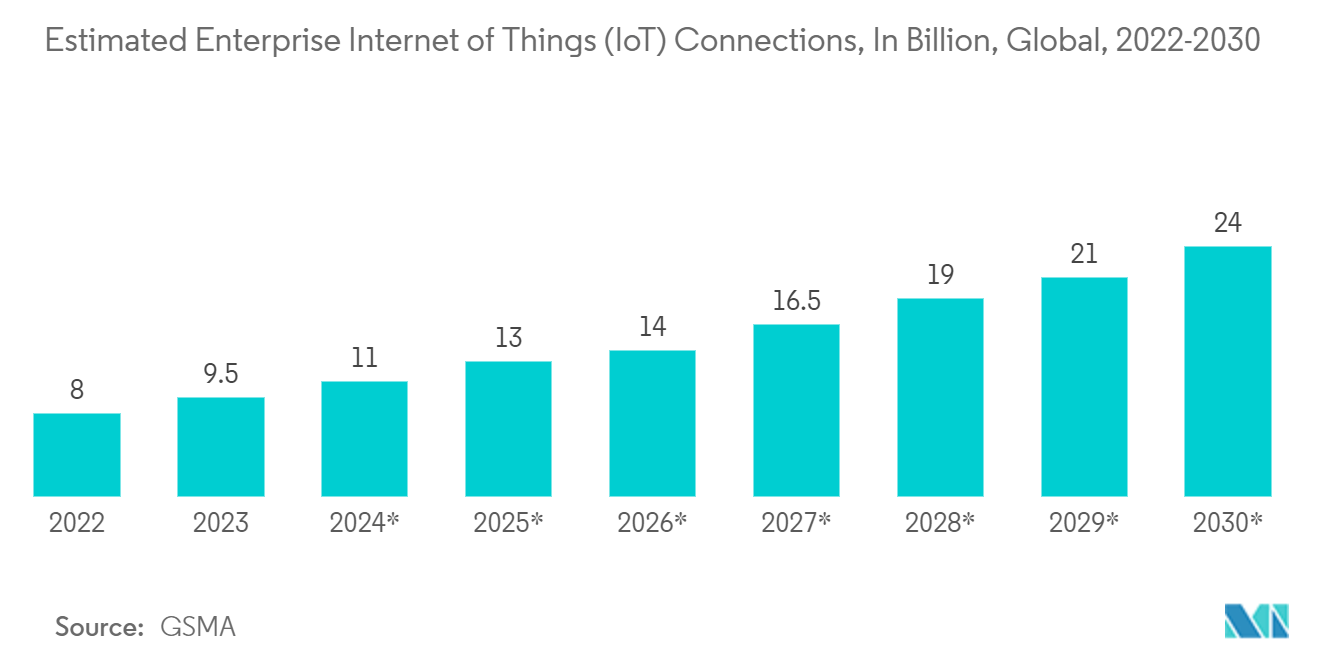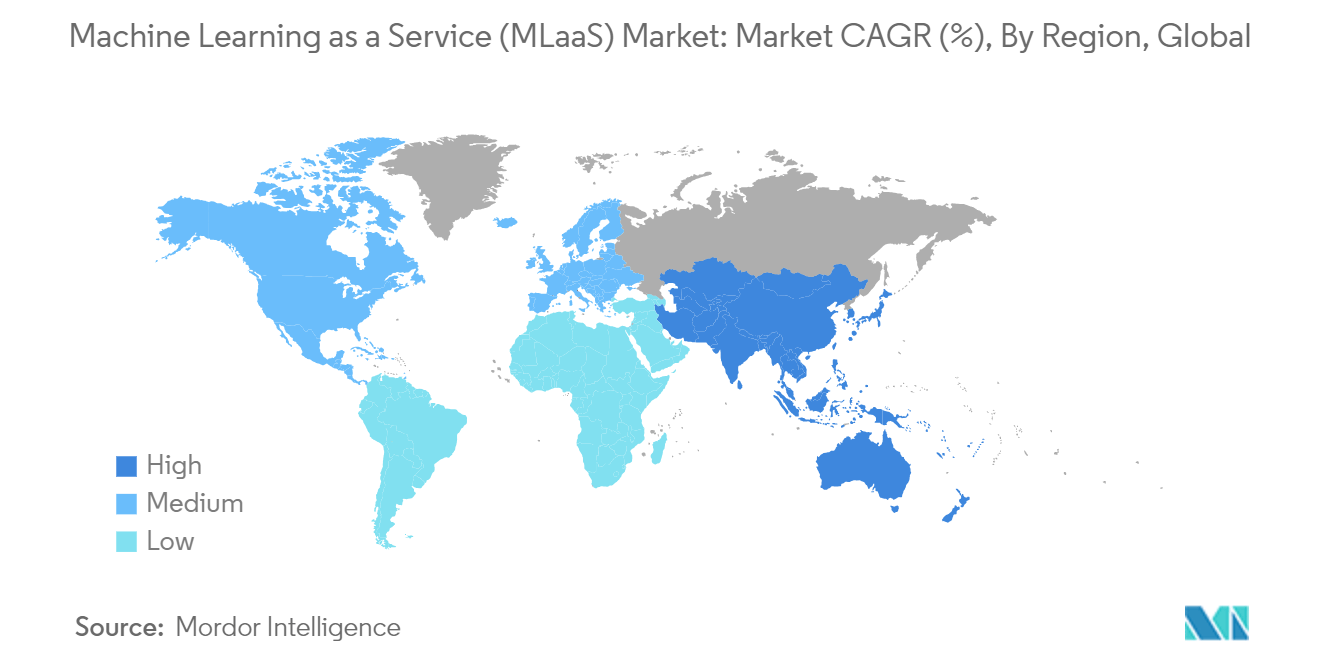Market Trends of Machine Learning As A Service (MLaaS) Industry
Healthcare to be the Fastest Growing End User
- The application of machine learning technology has been expanding at a significant pace in the past few years. Healthcare organizations worldwide are demanding machine learning technology to analyze vast amounts of patient data to identify patterns and make more accurate predictions about disease diagnosis, drug discovery, and personalized treatment plans. Due to these factors, the need to access machine learning tools and resources cost-effectively has driven the demand for MLaaS platforms in the healthcare sector.
- The demand for MLaaS is gaining significant traction in healthcare organizations to manage staff schedules effectively. Machine Learning as a Service (MLaaS) equips healthcare organizations with advanced scheduling algorithms. These algorithms are designed to analyze extensive historical data, enabling precise predictions of future staffing requirements. Further, the adoption of MLaaS in healthcare organizations eliminates the need to develop these complex algorithms in-house, saving them time and resources.
- In July 2023, Amazon Web Services Inc. (AWS) unveiled AWS HealthScribe, a HIPAA-eligible service. This service equips healthcare software providers to create clinical applications that leverage speech recognition and generative AI. The goal is to streamline clinicians' workflows by automating the generation of clinical documentation. AWS HealthScribe, backed by Amazon Bedrock, simplifies the integration of generative AI features for healthcare software providers.
- Notably, it offers this functionality for two key medical specialties—general medicine and orthopedics—eliminating the need for providers to handle the complex machine-learning infrastructure or develop their own large language models (LLMs). Such developments further support the market growth.
- By application other applications such as NLP, computer vision, and sentiment analysis are analyzed to gain significant traction in the healthcare sector. For instance, MLaaS platforms offer computer vision capabilities, spotting irregularities in X-rays, CT scans, MRIs, and mammograms, thus helping healthcare providers in diagnosing diseases. Furthermore, MLaaS platforms can also offer sentiment analysis services that can effectively measure patients' emotions, moods, or satisfaction levels.
- Therefore, the adoption of MLaaS platforms in the healthcare sector is analyzed to revolutionize the healthcare sector by helping healthcare providers to effectively diagnose diseases, monitor patients' health, drug discovery, and offer personalized treatment to enhance patient care.
- Additionally, the expanding use of IoT, notably medical IoT devices, and the growing adoption of cloud-based services in healthcare organizations worldwide will further bolster the growth of the MLaaS market in the healthcare sector over the forecast period.
- The increasing adoption of IoT in businesses fuels a heightened need to effectively extract meaningful insights from the vast data generated by IoT devices. This demand is propelling the rapid growth of Machine Learning as a Service (MLaaS), which is increasingly shaping data mining and enabling the creation of innovative business solutions. For instance, according to the data from GSMA, the number of enterprise Internet of Things (IoT) connections worldwide is forecasted to reach 24 billion by 2030.

North America Holds Largest Market Share
- North America is expected to hold a significant share of the market owing to its robust innovation ecosystem, fueled by strategic federal investments into advanced technology and complemented by the presence of visionary scientists and entrepreneurs coming together from globally renowned research institutions, which has propelled the development of MLaaS.
- For instance, in May 2023, The US National Science Foundation (NSF), in collaboration with higher education institutions, other federal agencies, and other stakeholders, announced an investment of USD 140 million to establish seven new National Artificial Intelligence Research Institutes (AI) institutes. Through this investment, the government aims to promote AI systems and technologies and develop a diverse AI workforce in the United States to advance a cohesive approach to AI-related opportunities and risks. Such investments by the regional government are expected to create new growth opportunities for the market studied.
- In addition, in March 2024, Intel announced a significant USD 100 billion investment in an expansion and upgrade initiative. This initiative includes establishing new manufacturing plants in four US states and enhancing current facilities, bolstered by the federal government's financial backing. The US government committed USD 19.5 billion in federal grants and an additional USD 25 billion in tax incentives to bolster Intel's expansion. Furthermore, Intel plans to construct "the world's largest AI chip manufacturing site" near Columbus, Ohio, within the next five years. Such initiatives in AI may further propel the studied market demand in the region.
- The region also witnessed a significant proliferation of 5G, IoT, and connected devices. As a result, communications service providers (CSPs) need to manage an ever-growing complexity efficiently through virtualization, network slicing, new use cases, and service requirements. This is expected to drive MLaaS solutions as traditional network and service management approaches are no longer sustainable. According to GSMA, North America's total number of consumer and industrial IoT connections is forecast to grow to 5.4 billion by 2025.


